(Photo courtesy of The Quintessence of Tonkin Facebook page)
PT: Hi guys! Have you ever wanted to escape the hustle and bustle of the city… without ending up in a crowded tourist trap?
TB: We get it. Sometimes you just want a change of scene—something peaceful, something meaningful. Somewhere you can breathe… and maybe feel a little more connected to the roots of a land.
PT: And we have found it, The Quintessence of Tonkin, just 25 kilometers west of downtown Hanoi, in Sai Son commune, Quoc Oai district. This cultural complex blends food, art, and tradition into one immersive experience.
TB: It’s Vietnam’s very first open air spectacle, designed not just to entertain—but to honor the beauty of Northern culture. You see it. You hear it. You taste it. You feel it with every sense.
PT: So… ready to slow down with us?
TB: We’re TB and PT. Follow our footsteps—or better yet, let us take you there.
TB: That voice. That call. That aroma of freshly steamed banh gio, a stuffed rice flour dumpling of northern Vietnam. It was the first thing we heard as we entered “The Quintessence of Tonkin.”
PT: Right through the red gate, we stepped into a Northern Vietnamese village market. And this one buzzed with the sounds, smells, and sights of our childhoods.
TB: There were thatched-roof stalls, big bamboo baskets full of sweet potatoes, peanuts, steamed corn, cassava, and puffed rice snack.
PT: It’s a living memory. And it welcomes you like family.
PT: Just as we were soaking in the atmosphere of the market, an old lady with a bright, warm smile waved us over to her tea stall.
TB: That was Ta Thi Tuat. Her little tea corner sat under a banyan tree, shaded and breezy. It seemed to attract every weary traveler like moths to a flame.
TB: And for good reason. That cup of nuoc voi or lid eugenia tea with ice was just what I needed after the bumpy car ride.
PT: I went for the green tea. Strong and slightly bitter, just the way my grandma used to make it.
TB: And the snacks! Peanut candy and Vietnamese nutty ginger sticky rice bars che lam. Love the flavor!
PT: There’s a reason tea stalls are such a big part of Northern culture. You don’t just stop for tea. You stay to talk, to listen, to rest.
TB: Somehow, the tea makes people open up. And before you know it, you’re chatting like old friends.
PT: Just like us that day. We stayed longer than we planned.
TB: But that’s the thing — here, you don’t rush. You let the moment brew, just like the tea. Ms. Tuat said that, "back in the day, our elders loved nothing more than a pot of nuoc voi — Vietnamese herbal tea made from the leaves of the lid eugenia tree called voi. Green tea and voi herbal tea are great for cooling down, but they taste totally different."
Green tea smells fresh and light, while voi has a stronger, kinda sharp scent, she said, adding that "If you use dried voi leaves or buds, the drink turns a bit red and doesn’t taste as nice. Fresh leaves are the best — they make the drink a bright green, like it’s full of life."
 Ms. Ta Thi Tuat at her tea stall, ready with a pot of warm tea to welcome guests. Ms. Ta Thi Tuat at her tea stall, ready with a pot of warm tea to welcome guests. |
PT: Sipping my cup of voi tea, I took a slow look around. Honestly, it felt like I had time-traveled into a Northern Vietnamese countryside fair from the old days.
TB: Yeah, it wasn’t anything like the modern weekend markets we often see. No concrete kiosks, no loud banners. Just simple stalls set up with bamboo tables and low chairs under giant banyan and bodhi trees.
PT: The food was all displayed in woven bamboo baskets. The vendors here weren’t just selling food — they were fully in character. Dressed in traditional farmer’s attire, complete with the ao tu than — the four-panel dress from Northern Vietnam — and even a silk headscarf tied in the “crow’s beak” style.
PT: Ms. Tuat was no exception. With her warm smile, she told us about the outfit and what life used to be like back then. She said, "This outfit I’m wearing is just like the old days. See the crow’s beak headscarf? That’s called khan mo qua. Back then, women also wore a yem — a kind of under-shirt — and carried a small cloth pouch for their money."
"Life was simple. We didn’t have much, so people would just gather in a small corner of the house to eat and drink tea," she said, adding that "Like at my place, I’d brew some tea and invite the ladies over. We’d sit around, sip tea, and chat — about farming, planting, harvesting… everyday things. That was life in the countryside."
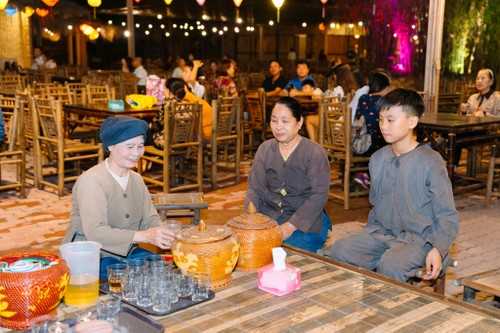 The traditional outfits of Northern Vietnamese farmers The traditional outfits of Northern Vietnamese farmers |
PT: We noticed some of the vendors collecting coupons from customers before handing out food.
TB: Oh right — the coupons! There’s no direct transaction here. No cash, no QR codes, no bank cards. Just like the old days.
PT: Exactly. Guests had to queue up at the entrance to exchange their money for paper coupons, kinda like how our grandparents used to buy food with stamps back in the subsidy period in the 70s and 80s.
TB: Yeah, and they even told me stories about placing bricks in line at dawn just to save their spot — so they wouldn’t miss their turn!
PT: It’s such a subtle detail, but honestly, one of my favorite parts of the whole experience. It really makes you slow down and connect with how things were done.
TB: Once we got my coupons, we followed this amazing smell — a nearby stall was serving up all kinds of traditional rice cakes. And I mean cakes — plural!
 Rural delicacies you simply can’t take your eyes off. Rural delicacies you simply can’t take your eyes off. |
PT: There they were, the rice cakes neatly arranged in a bamboo basket — bánh gio, banh te, banh nep — each one soft, sticky, and still steaming. The moment I saw them, my mouth watered.
TB: Oh, I could smell the sweetness in the air already. These rice cakes are a real Northern specialty. We couldn’t wait to try them. We went straight to the stall where Ms. Nguyen Thi Thuy, the seller, was serving them up. She briefly described the ingredients to us, and trust me, I was already hooked.
Ms. Thuy said, “banh gio is made with rice flour and stuffed with pork. Then we’ve got bánh te — simple, savory rice cakes, and bánh nep, made with sticky rice and filled with either mung beans or peanuts.”
PT: In all these dishes, rice is the main ingredient. Depending on the type of rice used, each cake has its own unique flavor. It’s incredible how something so simple can taste so different.
TB: Exactly! And guess what? Ms. Thuy’s stall was a real magnet for foreign visitors. One of them was Manu Zacharia from India—and he was surprisingly confident ordering in Vietnamese!
PT: Yeah, it was really fun to watch. And you should’ve seen his face when he took his first bite! He was genuinely amazed by how soft and flavorful the cakes were. It’s such a great moment to share with someone experiencing these Northern specialties for the first time.
Manu said, "
I think it's a healthy one because there is not much sweet. It's healthy. Since it is boiled, you are not using oil. So, I think it's a good dish to try. Mix it with the sauce. Good one. We have a similar one, but not exactly like this. We have a similar one. Yeah. But probably, it's using a different mix."
"There are so many, you know, kinds of snacks that we use very similar to this which is a combination of rice, flour. Sometimes, they put nuts like this and then they steam it. They steam it or bake it and then it looks something like this," he said.
PT: It’s so interesting to hear how similar dishes exist in different cultures! And I agree with you, Manu, the simplicity of these rice cakes really makes them stand out.
TB: Northern Vietnam’s specialties aren’t just about flavor — they’re a window into the culture. But you know, culture isn’t just something you taste…
PT: …It’s something you experience — in the way we gather, the way we celebrate, and yes, the way we play. At The Quintessence of Tonkin, folk games are just as important as food in bringing the past to life.
 New to the game? Don’t worry, just jump in and dance. New to the game? Don’t worry, just jump in and dance. |
TB: True! No traditional Vietnamese festival is complete without folk games. They’re full of energy, fun, and community spirit.
PT: Yeah, we saw people enjoying all kinds of games that day, bamboo dancing, tug-of-war, and jump rope.
TB: I was personally into the smashing clay pots while blindfolded!
PT: That was fun for sure!
TB: Just a few steps away from the food stall, a group of children gathered around a board carved into the ground for the traditional stone game - O An Quan. It looked a bit mysterious to anyone unfamiliar with it — 12 small pits, 2 larger ones, and pebbles being moved around. As I was trying to remember the rules, a young boy caught my attention for his winning streak. 7-year-old Bui Phuc Huy took his turn with quiet confidence and soon captured stones from his opponent.
Huy said, " At first, I didn’t really know how to play. But after my mom explained the rules, I finally understood how it works. And in the end, I won! Actually, many of my friends play this game at school but I haven’t tried it. There are dozens of spots to play, and the boards come in different shapes — some are triangular, some rectangular, and some even circular."
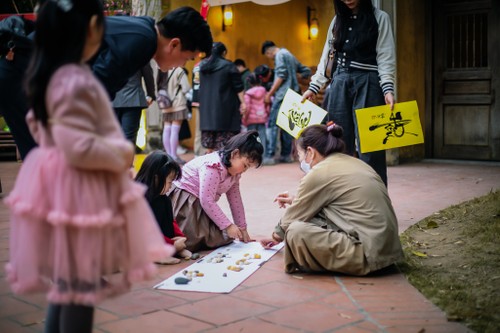 O An Quan – an old-school board game that involves nothing but some pebbles and curious minds. O An Quan – an old-school board game that involves nothing but some pebbles and curious minds. |
PT: It’s great to see kids like Huy enjoying these traditional games. It really keeps the culture alive, doesn’t it?
TB: Yeah, totally! Huy and his little sister came to The Quintessence of Tonkin for the first time to get a feel for their heritage. They don’t really get that chance back home, so their mother, Tran Hai Yen, decided to bring them here.
She said, "I just wanted my kids to learn more about the old-school culture of Northern Vietnam. When I was a kid, we didn’t even know the difference between cows and buffaloes! I want them to understand what farming life was like back then, how the rice culture worked, and how people lived. I hope they’ll grow up knowing that being Vietnamese is something special and different from other countries."
PT: The entire space buzzed with energy and laughter. And just as the energy reached its peak, a gentle melody started to float from the front stage…
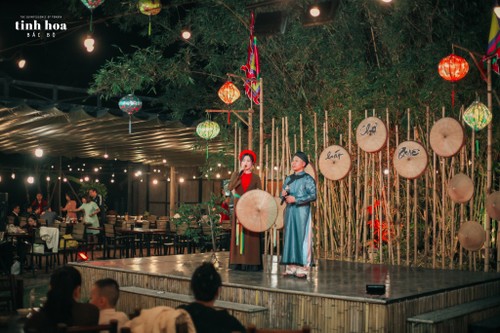 What’s more Tonkinese than enjoying Vietnamese delicacies while listening to the soothing melodies of quan ho? What’s more Tonkinese than enjoying Vietnamese delicacies while listening to the soothing melodies of quan ho? |
TB: Right — the first soft notes of “Welcome to my house” drifted in from the front stage. It’s one of the most iconic quan ho or call-and-response folk songs. And when you hear it, you just know something special is about to begin.
PT: Everyone turned toward the stage, where a duo had just appeared in full quan họ attire. The woman wore a multi-layered traditional dress with a round flat hat and a silk scarf. The man stood beside her in a long tunic and head turban — both calm, composed, and smiling gently.
TB: What followed was something truly timeless — a quan họ performance, or more precisely, a musical dialogue between male and female vocalists (we call it lien anh and lien chi). This isn't just singing; it's a cultural ritual of call and response, known in Vietnamese as giao duyen, which literally means “exchanging affection.”
TB: I bet these melodies sound especially familiar to you, Thao — you’re from Bac Ninh, after all, the birthplace of quan ho!
PT: That’s right! This singing tradition has been around for centuries and is especially tied to the northern provinces of Bac Ninh and Bac Giang. It’s so culturally significant that UNESCO named quan họ the Intangible Cultural Heritage of Humanity in 2009.
TB: Back in the day, quan họ was sung during village festivals to welcome guests, celebrate spring, or simply spend time together under the moonlight.
PT: After the quan ho performance, at around 7PM, the crowd quieted once more as a calm male voice came over the loudspeakers…
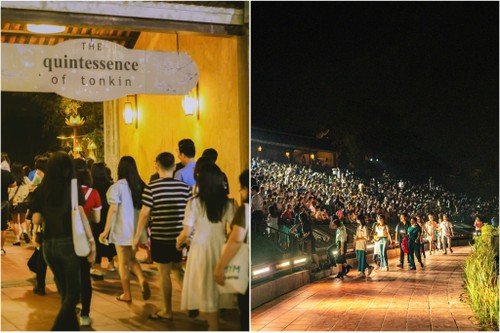 Guests gather at the main stage, ready for a one-of-a-kind experience Guests gather at the main stage, ready for a one-of-a-kind experience |
TB: It’s time for The Quintessence of Tonkin, a real showstopper, and the biggest highlight of the entire experience.
PT: It’s a one-of-a-kind live spectacle — an open-air theater set on a shallow body of water, just ankle-deep. This immersive stage setup alone is already something to behold.
TB: As everyone began to wrap up their games and food, you could feel the energy shifting. The flicker of lights being tested, the silhouettes of performers getting into position, the softening chatter of the crowd — it all built up to something magical.
PT: Through stunning visuals, folk melodies, and carefully choreographed scenes inspired by real traditions, the show brings to life centuries of Northern Vietnam culture — from ancient legends to village celebrations.
TB: And it began with quiet poetry. As the lights dimmed, a gentle voice began reading… The stage turned into a living canvas with the first scene — “Poetry”. Inspired by 19th century scholar-poet Nguyen Khuyen’s “Fishing in Autumn”, the folk song “Scooping water by the Pavilion”, and traditional northern lullabies.
PT: I loved that moment. The lighting, the music, the slow rhythm — everything came together so smoothly. It really felt like stepping into a painting.
TB: Right! And the way the young girls sat by the pond, playfully dipping their feet in the cool water...
PT: ...while the boys tried their best to impress them — so charming and awkward at the same time!
TB: That scene captured so much of rural life back then — gentle, nostalgic, but full of heart.
PT: Yeah, it reminded me of the kind of stories our grandparents used to tell. A slower time, but one rich with poetry, tradition, and connection.
TB: In the background, villagers were busy tending crops, feeding animals, and casting large fishing nets into the river. All around, you could hear the soft lullaby ringing through the bamboo groves — so peaceful and beautiful.
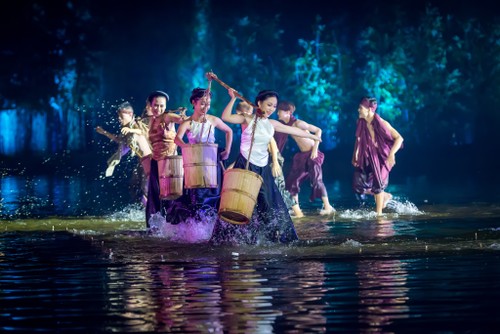 A heartwarming scene of young villagers at play. A heartwarming scene of young villagers at play. |
PT: That part of the show really brought the countryside to life. I couldn’t help but notice something pretty surprising, though…
TB: Oh, really? What caught your attention?
PT: Well, to the left side of the stage, there was Ms. Thuy, the “banh gio” lady, and Ms. Tuat, the one with the tea stall. They were both there — right in the middle of the performance, just as if they’d been a part of the show all along.
TB: That’s incredible! I didn’t realize they were involved in the production.
PT: And here’s where it gets even more interesting. Mr. Tran Van Vu from the Tuan Chau Group, the company behind The Quintessence of Tonkin, told me a little “secret”.
He said that most of the performers are actually from the local community of Sai Son. "Why did we choose them? Because, at the heart of The Quintessence of Tonkin, we’re presenting a real-life performance. And to capture the essence of Northern Vietnam, it has to be portrayed by people who live and breathe that culture," he said.
Vu added that "when our guests watch, it feels so authentic, so natural. It’s almost like the actors aren’t even acting — they’re just being themselves."
TB: That’s really something! The authenticity of the show is so striking, especially when you know the cast is from the actual area.
PT: True! And what I found even more amazing was that they have people of all ages involved. The youngest performers are around 10-12 years old — local kids from Sai Son who join in after school. And at the other end, you’ve got older performers, some over 70 years old, still taking part in key scenes.
Vu continued, "We have everyone, from young children to elderly women, all participating in the show. In the scenes set in the fields, you’ll see the community’s elders working alongside the children. It really reflects the continuity of tradition."
TB: That’s such a beautiful way to bring the community together — and to showcase generations of culture.
PT: And again what really stood out to me was seeing Ms. Thuy, the “banh gio” lady, perform in the water-scooping scene.
Thuy said, "We used to sing while scooping water, and we’d follow the rhythm of the music. It felt just like working in the fields. We’d have to scoop water to irrigate the rice, especially after planting."
"Back then, we didn’t have machines — we had to use the gau song (a traditional bucket and pulley system). But now, with this show, it’s like reliving those memories of farming, planting rice, and taking care of the water buffalo. It brings back the old days, when everything was done by hand," she added.
TB: Wow, I can feel the nostalgia in her words. She’s not just acting; she’s revisiting a part of her life that shaped who she is today. That’s what makes the performance so unique.
PT: And just when you thought you’d seen it all, the entire stage transforms. The lake becomes still, the lights dim, and you hear a soft chant in the distance.
 A mesmerizing blend of visuals, props, lighting, and performers leaves audience in awe. A mesmerizing blend of visuals, props, lighting, and performers leaves audience in awe. |
TB: This scene, I mean, the "Buddhism" scene was really something, wasn’t it? It told the story of Vietnamese Zen Master Tu Dao Hanh in the late 11th century and early 12th century.
PT: And what makes it even more special is that Thay Pagoda, which honors Tu Dao Hanh, is one of the oldest Buddhist temples in Vietnam. It’s right here at the foot of Sai Son Mountain, so the performance really ties into the history of the place.
TB: Yeah, you could really feel the connection to the land when that pagoda started rising from the water, glowing in golden light. It was such a magical moment!
PT: It was amazing. That this scene is one of the highlights of the whole show. Mr. Vu said that the two most wow-worthy moments are when the pagoda rises and the scene about Tu Dao Hanh. He’s the one who founded Thay Pagoda, and some say he even invented Vietnamese water puppetry, he added.
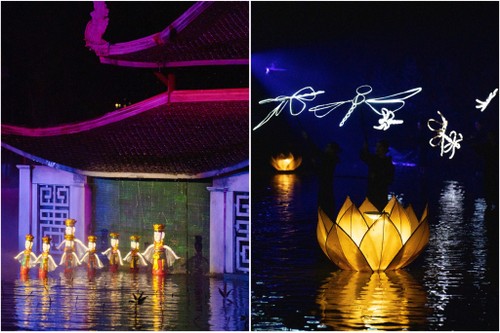 Water puppetry and glowing dragonflies glide over the water. Water puppetry and glowing dragonflies glide over the water. |
PT: It’s so cool how they connected everything to this place. That rising pagoda wasn’t just a pretty effect—it felt like it had real spiritual meaning.
TB: For sure! And then we saw Tu Dao Hanh by a lotus pond, with dragonflies flying in the light. And the water puppets, which are said to be his creation, danced across the water. It was such a beautiful way to bring the story to life.
PT: Yeah, it was like the spirit of Sai Son was speaking through the stage. And when the pagoda slowly sank back into the water, the whole atmosphere changed.
TB: Yeah, like the “Nostalgia” scene — remember that? We were suddenly in the ancient capital of Thang Long, now Hanoi, right in the middle of royal exams. Young scholars in ao dai and turban were deep in study. You could even hear the soft brush strokes on paper.
PT: Then boom — that wooden board with the top names appeared, gongs rang out, fire torches lit up the stage, and everyone was cheering. You could almost feel their pride and excitement.
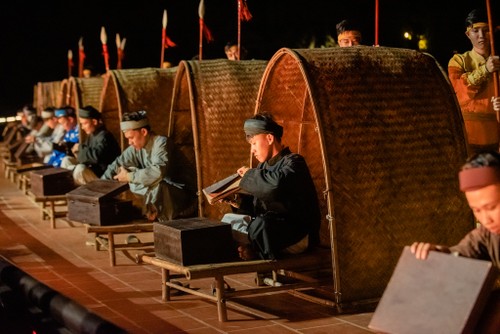 Old-day scholars burn the midnight oil lamps in preparation for the royal exam. Old-day scholars burn the midnight oil lamps in preparation for the royal exam. |
TB: And right after that intensity came something softer — the “Music & Painting” scene. It was inspired by the To Nu female figures from Hang Trong folk art. Four women played traditional instruments like the bamboo flute, the 2-chord fiddle, the moon-shaped lute, and the ty ba - a plucking stringed instrument.
 A recreation of the To Nu painting with graceful movements. A recreation of the To Nu painting with graceful movements. |
PT: And just when you thought it couldn’t get any dreamier…
TB: “Peace & Harmony” stepped in. The stage went misty and quiet. A golden lotus-shaped pavilion appeared, glowing under soft yellow lights. Then came the haunting sound of Chau van, a highly rhythmic form of singing that often accompanies “hau dong” (mediumship) during rituals to honor the Mother Goddess or connect to other gods. It is usually performed in temples.
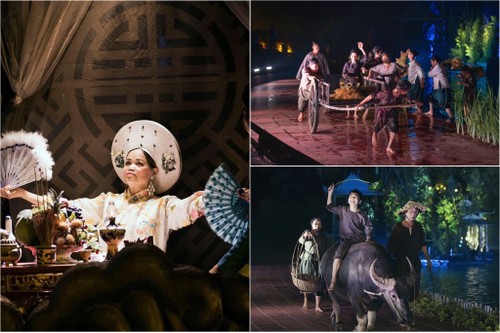 Highlights from the “Peace & Harmony” chapter. Highlights from the “Peace & Harmony” chapter. |
PT: As the final scene began, the whole stage lit up. The air was filled with laughter, cheers, the beat of drums, and familiar folk tunes.
TB: Villagers in bright traditional clothes came out, carrying flower palanquins, waving flags, and playing folk games. It felt like a real countryside festival!
PT: One of the crowd favorites? Bamboo dancing! It’s a folk tradition from ethnic groups in northwestern Vietnam, usually done to welcome guests and wish for good luck.
TB: What made it even more fun was that the lien anh and lien chi — those lovely quan họ singers — didn’t just stay on stage. They walked around, hand-in-hand, inviting the audience to join the dance.
PT: And people did! Locals, tourists, kids, grownups — everyone jumped in. Some stumbled, some nailed it, and some just made up their own moves. But in that moment, we were all part of the show.
 Everyone comes together in joy and laughter for a final dance before parting ways. Everyone comes together in joy and laughter for a final dance before parting ways. |
TB: As things wound down, the whole cast slowly walked toward the foot of Thay Mountain, singing a beautiful, familiar quan ho song.
PT: “Don’t leave just yet. Stay, my beloved!” — it was more than just a lyric. It felt like a warm invitation to hold onto the moment, to feel something deeper, and to come back one day. Here’s what some of our visitors had to say:
"What wowed me the most was that final scene — the quan họ song, and how all the performers came out together to greet the audience. It was so moving. If there’s one message I’d like to send to young people, it’s this: Go see it. Just go experience it for yourself. You’ll really feel the beauty and unique charm of Vietnamese culture and the heritage passed down from our ancestors, all brought to life in this show.”
"I think I don't even have the words to describe how beautiful this was. if you are privileged enough to come here, you should really come to see this show. I will definitely pass the word to tell my friends and family that this is a very unique experience and you really need to come here."
"I love everything about it. The story behind it. I feel amazed. I'm hypnotized. Everything was beautiful. I enjoyed it. My family enjoyed it."
If you want a taste of the show for yourself, you can visit every Wednesday, Saturday, and Sunday from 4pm to 9pm. Tickets range from 30 to 46 USD.
Bring your friends and families and make the most of the experience. We’d love to hear from you. Drop a message at our Facebook page VOV5 English Service.